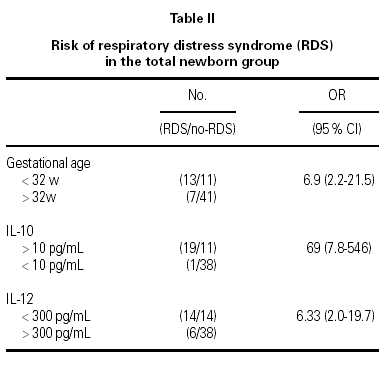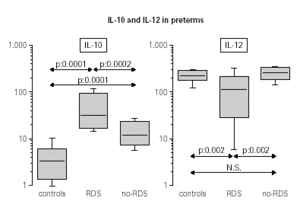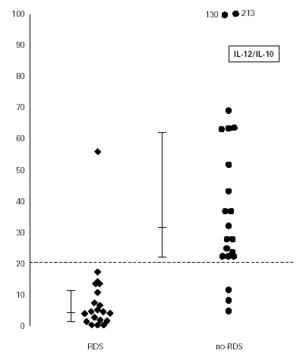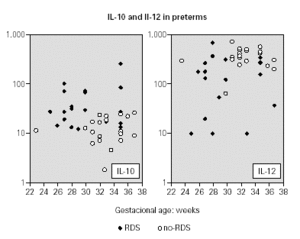Abbreviations: IL-12/IL-10: interleukin-12/interleukin-10; RDS: respiratory distress syndrome; Th1/Th2: T1/T2 helper lymphocyte; NK: natural killer cells; TNF: tumour necrosis factor; IFNγ: interferon gamma.
INTRODUCTION
IL-10 has a potent activity in immunosupression, specially directed to Th1 cells, by inhibiting both IL-12 and IFNg synthesis1. The feto-placental unit synthesizes IL-10, involved in the suppression of cellular immunity and induction of HLA-G expression in the human trophoblast, therefore protecting the fetus from rejection2,3. By contrast, at the time of delivery there is a Th1 response with increased IL-12 levels, as occurs in graft-versus-host reactions4. IL-12 has a potent Th1 effect, involved in defence mechanisms against intracellular pathogens and in delayed-type inflammatory reactions. Moreover, IL-12 induces IFNγ synthesis by T and NK cells5. The predominance of Th2 cytokines is associated to normal pregnancy, whereas Th1 is involved in recurrent spontaneous abortions2,4. The fetal Th2 predominance remains in the newborn for several weeks postdelivery6.
Serum IL-10 levels are increased in preterm infants and we have previously reported an inverse correlation between IL-10 cord blood levels and gestational age7. Here, we investigate the possible role of this interleuklin in preterm newborns with respiratory distress syndrome (RDS), which it is also related to gestational age. Besides, the imbalance between IL-10 (antiinflammatory) and IL-12 (proinflammatory cytokine) are also studied.
PATIENTS AND METHODS
Patients
The study was performed in 41 preterm infants with a mean gestational age of 32 weeks (range 25-37). Weight at birth ranged between 480 to 3,160 gr. Only one newborn had low weight for gestational age (< Pc10). Respiratory distress syndrome (RDS) was shown in 20 cases, and the diagnosis was reached by clinical and radiological findings and the course of the disease. All newborn with RDS were ventilated with a continuous positive airway pression (CPAP). The severity of the distress was assessed according to days of assisted ventilation, and referred as mild when less than 5 days, moderate between 5-10 days, and severe when more than 10 days. Antenatal steroid therapy was not administered to any case included in the study.
Neonatal sepsis was found in 5/20 cases and 7 premature infants died. There were differences affecting gestational age (median 29.5 vs 32 w; p: 0 > 0.5) and weight (mean 1230 vs 1720 gr; p: < 0.05) between groups, premature with and without RDS, but the type of delivery and the frequency of sepsis were similar (table I). Analysis determinations could be repeated in 11 preterm infants with 2 to 14 days of life, and without signs of infection or respiratory distress at that time. The results were compared to those obtained from a group of 31 healthy full term infants. The delivery was vaginal in all but 18 cases undergoing a caesarean section due to different problems: 5 had RDS, 6 without RDS and 7 full-term controls. None of the cases included in the study developed bronchopulmonary dysplasia.
The study was approved by the Ethical Research Committee of the Faculty of Medicine of University of Valladolid and performed according to ethical procedures.
Techniques
Blood samples were obtained from umbilical cord. After centrifugation for 10 minutes, serum samples were separated and frozen at 20 °C until the study was performed. Cytokines were measured by an ELISA test (Endogen, USA), using two no-competitive monoclonal antibodies reacting against different epitopes of the IL-10 or IL-12 molecules. The IL-12 kit measure total IL-12 (p40 + p70). Using these tests, no cross-reactions with other cytokines, such as IL-1, IL-2, IL-6, tumour necrosis factor (TNF) or interferon gamma (IFNγ) are detected. The inter- and intra-assay variations were below 10 %. The final sensibility of the tests was 1 pg/mL for IL-10, and 3 pg/mL for IL-12.
Statistical analysis
The values showed a non-parametric distribution, so results are expressed as median and the Mann-Whitney U-test and the Spearman coefficient were used to assess differences and correlations between two groups, respectively. The Bonferroni ANOVA was used for comparing preterm with RDS group, preterm without RDS and term newborn controls. For age matching, differences between preterm groups were repeated after suppressing cases with less than 26 gestational weeks, 28 w., 32 w. and so on. A logistic regression model, using logarithmic transformation, was used for calculating the RDS risk variation according to the IL-12/IL-10 ratio. Sensibility and specificity value and OR (95 % CI) were calculated for groups with high and low gestational age (> 32 w. <), IL-10 (> 10 pg/mL <) and IL-12 value (> 300 pg/mL <). Differences were considered significant when p value was < 0.05.
RESULTS
General results
At birth, preterm infants with RDS showed higher IL-10 (27 vs 10.8 pg/mL, p: 0.0002) and lower IL-12 levels (188 vs 384 pg/mL, p: 0.002) than premature newborns without (table I). Similar results were found when compared to full term infants (IL-10: 3.2 pg/mL, p: 0.0001 and IL-12: 352 pg/mL, p: 0.002) (fig. 1). These results were confirmed by ANOVA Bonferroni test, assesing the three groups (IL-10, p: 0.0001 and IL-12, p: 0.005). No significant differences were found according to the severity of the RDS, although IL-10 and IL-12 levels were higher in cases with severe forms as compared to mild forms. No signficant differences were found in the group of 5 cases with sepsis. Children who died later showed higher IL-10 levels (p: 0.05) and a lower IL-12/IL-10 ratio (2.3 vs 11.0; p: 0.03) compared to survivor children. The IL12/IL10 ratio was lower in preterm newborns with RDS (4.6 vs 32; p: 0.0001) than in cases without RDS.
Figure 1.--Preterm infants with RDS showed higher IL-10 and lower IL-12 levels in cord blood compared to premature infants without RDS. Similar results were found when compared to full term infants.
We found that the best discrimination was obtained setting up the cut-off point of the IL-12/IL-10 ratio at 20 value. Only 1/20 (5 %) child with RDS and 18/21 (86 %) without RDS showed levels above this point (sensibility 0.95; specificity 0.86) (fig. 2). Similar results were found when the cut-off point for IL-10 was raised to 10 pg/mL (sensibility 0.95 and specificity 0.77), nevertheless they were lower with IL-12 for a cut-off point at 300 pg/mL (sensibility 0.70 and specificity 0.73). The risk of RDS related to cord blood IL-10 level > 10 pg/mL (OR 69; CI 95 %: 7.8-546) was higher than the risk for IL-12 levels < 300 pg/mL or the gestational age < 32 weeks (table II)
Figure 2.--The IL-12/IL-10 ratio was lower in preterm newborns with RDS (p:0.0001). A cut-off point at 20 showed a sensibility of 0.95 and specificity of 0.86.
The gestational age showed a strong negative correlation with IL-10 levels in the overall group of newborns (Z:-6.18; p: 0.0001) and in both preterm groups (Z:-4.56; p: 0.0001), but there was no correlation with IL-12 levels. On the other hand, IL-10 and IL-12 levels show no correlation with each other in any of the three groups. In the following days after delivery, the most striking finding in the 11 followed-up cases was the decrease in IL-12 levels, particularly in those with RDS (p: 0.0007) but also in premature infants without RDS (p: 0.004). By contrast, IL-10 levels decreased only in the group with RDS (p: 0.04) but not in those without RDS. No differences were found on weight, gestational age or cytokine levels among the group of infants born by caesarean delivery.
Results after correcting the gestational age
Newborns with RDS were younger than those without RDS (30 vs 32 weeks; p: 0.04), and they had lower body weight (1,230 vs 1,720 gr; p: 0.04). Nevertheless, these circumstances do not justify the strong difference found in IL-10 and IL-12 levels, because results did not change after correcting the gestational age effect (fig. 3). When a stratified study by gestational age was performed for groups > 28 and > 30 weeks, the birth weight and the gestational age were no different between RDS and non-RDS groups, whereas differences in IL-10 and IL-12 levels maintained the statistical significance (table III). Using a regression model with logarithmic data we found that the increase of 1 log unit of IL-10 levels was equivalent to the increase 12.01 times the RDS risk. On the contrary, the risk decreases 1.42 times for every 50 units of IL-12 increase.
Figure 3.--The gestational age was lower in cases with RDS compared to those without RDS, but results did not change after a correction of the gestational age, by suppressing cases with less than 30 weeks.
DISCUSSION
We had previously reported high cord blood IL-10 levels in normal preterm infants, and an inverse correlation with gestational age7, in agreement with other studies. The increased IL-10 expression in placenta in a gestational age-dependent manner followed by down-regulation at term may be underlying the mechanism of the delivery8.
It is well known that RDS is strongly associated to gestational age. According to these findings, high cord blood IL-10 levels in RDS infants may be the expression of a biological immaturity of the fetus, independently of gestational age. By contrast, cord blood IL-12 levels were not related with gestational age, even though it tends to increase. Both premature and full term infants showed very high IL-12 levels at the time of delivery with a trend to decrease in the following days after birth7.
An alternative explanation may be related to the antiinflammatory role of IL-10, manifested by its potent inhibitory effect on a vast array of cells and cytokines, particularly on Th1-type cytokines9. Surfactant deficiency in preterm infants leads to RDS, although some data also suggest a participation of local inflammation10. The study of inflammation in RDS is currently a matter of great interest. An interstitial inflammation was observed by immunohistochemistry in 40 infants who died due to acute RDS in the first week of life, with a maximal process at 72 hours of age, though it began within hours of birth11. Moreover, circulating polymorphonuclear leukocytes are activated in preterm infants with RDS and this seems to play a role in pathogenesis, with leukocyte activation present only two hours after birth12-14. Nevertheless, the inflammation is transient, vanishing by day 7-10 unless chronic lung disease is developed13. Nevertheless, at present there is little evidence supporting a prominent antiinflammatory role of IL-10 in the prevention of chronic lung disease15. After LPS injection, IL-10 knock-out mice undergo a chronic disease similar to human ulcerative colitis, with cachexia, anaemia and shock16,17 but it is striking that they do not develop lung disease, as it occurs in TGF-β knock-out mice18. IL-10 seems to be not related to airway inflammation, on the contrary, it has been found associated to recurrent wheezing and bronchial hyperresponsiveness in different experiment models19-21. In summary, an antiinflammatory role of IL-10 in fetal lung is not proved.
The main general stimuli for IL-10 secretion are proinflammatory cytokines, such as IL-1, IL-12, IFNγ, or TNFα22 and it is noteworthy that steroids have an inhibitory effect on IL-10, though it is not clear whether this is the result of a direct effect on the cytokine, or a consequence of the depression of proinflammatory cytokines, which are very active in IL-10 stimulation22,23. During pregnancy, the regeneration and tolerance factor (RTF) expressed by tissue at the maternal interface and all the pregnancy-specific glycoproteins (PSGs) induce IL-10 secretion23-25.
In an early study using bronchoalveolar lavage samples from preterm infants, no soluble IL-10, or IL-10 mRNA cellular expression were detected, whereas most samples from full term infants had positive results26. However, later studies showed detectable IL-10 levels in 50 % of bronchoalveolar samples from 17 premature infants15. These contradictory results are not relevant to our findings because bronchoalveolar lavage samples were obtained several days after birth. We have found increased serum IL-10 levels just at the time of delivery, decreasing later in postnatal life and becoming undetectable in a high percentage of samples. We should probably have to consider the delivery as a challenge test, when the feto-placental unit produces high amounts of different cytokines, due to a potent stimulus, which later disappears.
None of the infants included in our study developed bronchopulmonary dysplasia, and therefore we were unable to draw conclusions on this interesting aspect. We are planning a different experimental design to address this issue.
As occurs with other cytokines, the effect of IL-10 might be not exclusively anti-inflammatory, and different and even contradictory effects of IL-10 in particular situations are known. In adult healthy volunteers, it has been reported that after the injection of endotoxin, a high dose of IL-10 increases the effect of proinflammatory cytokines27. Others have shown that the tracheal instillation of IL-10 in animals highly increases bronchial hyperresponsiveness, and knock-out mice do not show bronchial response induced by allergens28.
In conclusion, decreased IL-12 and, very specially, increased IL-10 levels were found in cord blood from the premature newborns, which developed RDS. The results were independent of gestational age, therefore the IL-12/IL-10 ratio give us more useful information on RDS risk than age or weight. Nevertheless, it remains unclear whether the increased IL-10 levels, besides reflecting functional immaturity of the newborn, has any role in the inflammatory process affecting the development of RDS.
ACKNOWLEDGEMENTS
This article was partially supported by a research grant from Consejería de Educación de la Junta de Castilla y León. Spain (ref EV13/98).


















